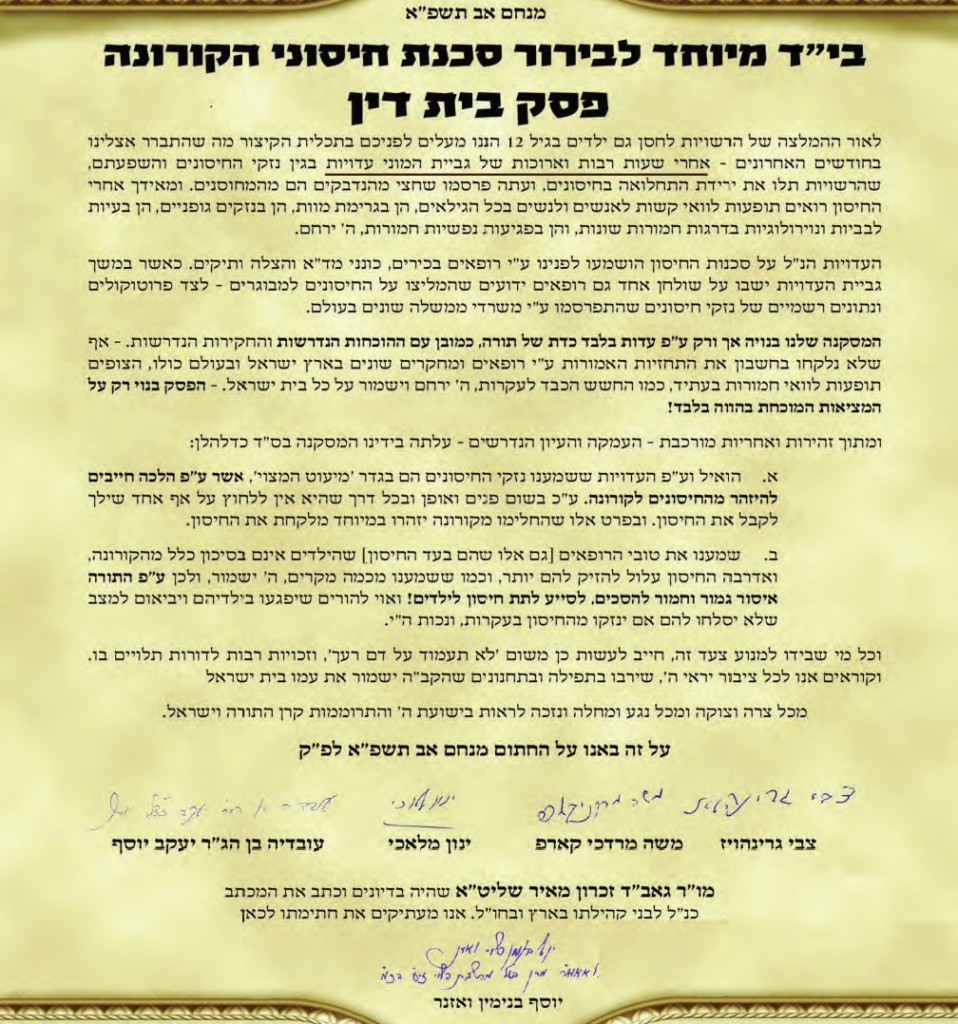חשכת הגלות בעוונותינו הרבים – ותשובה היא התשובה, כפשוטו
הגיע הזמן לחזור בתשובה / הרב אריה סגל
הכל מכירים את מאמר רז”ל “כל דור שלא נבנה ביהמ”ק בימיו כאילו נחרב בימיו”. וכולנו – יודעים, כי אם רצוננו בבנין הבית ובהשבת השכינה לציון, צריכים אנו לתקן את העוונות
המעכבים, וראוי לנו להתבונן בחטאים הגורמים לחורבן ולתקנם ולשוב לפני ה’.
כתב הרמב”ם בתשובה לחכמי מונטשפלייר על דבר השפעת המזלות, כי “זאת האמונה היא אשר החריבה את ביתנו ושרפה את היכלנו בבית ראשון, כי יען והאמינו בהשפעת הכוכבים – שמו את עיקר בטחונם בהם ולא עסקו בלימוד חכמת המלחמה והכנת כלי זין וכיו”ב, וע”כ נפלו”. הנה לקח הרמב”ם את הדבר הידוע שנחרב בעוון ע”ז ופירשו כן. ולמדנו מתוך דבריו – – הקדושים לימוד גדול, כי אף שעל חטאם חרב, מדרכי הנהגתו ית’ כי החטא עצמו הוא אשר יביא את העונש, ככתוב “תמותת רשע רעה”. וכן מצאנו במצרים, שטבעו בים בעוון רדפם – אחר ישראל, והנה רעתם היא היא זו שהכניסתם לים, וממילא טבעו. וכיו”ב י”ל על שנאת חנם שהחריבה את הבית השני, שמדרכי הנהגתו ית’ להביא ששנאה זו תביא את החרבן כאשר לא התאחדו להלחם באויבים כראוי, ועי’ בספר יוסיפון. וא”כ אף אנו כאשר נרצה לידע את העוון – אשר בגללו רחק קץ גלותנו, יכולים אנחנו להתבונן במה שמעכב כאן את בנינו ולדרוש מתוכו
את העוון שיש לנו לשוב ממנו, וה’ יעזרנו על דבר כבוד מלכותו.
והנה כשנתבונן מהם הדברים המעכבים, נראה כי שלשה הם –
האחד שנאת חנם. ואין עיקר הכונה לשנאה ששונא אחד את רעהו, שאף שעוון גדול הוא, – מ”מ אי”ז המעכב את הבנין. אלא עיקר הדבר מכוון לשנאה ששונאים בני קהילה פלונית את בני עדה אלמונית, ובני ישיבה פלמונית את רעותה, וכיו”ב, שכן כך עוד אין אפשרות לבוא כאגודה אחת אין יכולת לעשות דברים ציבוריים [ויש צורך להאריך, אך אין מקום…]. ואף – שכמובן, הקהילה שלי היא הצודקת בכל, ואלו מן הצד השני אינם אלא טועים או חוטאים – מ”מ יש לדעת, כי זה המחריב את ביהמ”ק. ואם יש את נפשך לומר כן ‘נחריב את הבית, נגלה – את ישראל’ וכו’ וכו’, ובלבד שנמשיך להלחם את מלחמת הקודש נגד … כי אז אין מילה בפי. אך אם מבין אתה את אשר לפנינו, דע כי ישנה צורה איך אחים מתוכחים, וכיצד רבים. וכאשר תתקן אתה את עצמך ואני את עצמי, אט אט ילך העולם ויתוקן, ותחזינה עינינו. וכמובן, כי אף מריבה שבין איש לרעהו נכללת בזה, כי כשננהג כרצון ה’ וציוויו בין אחד לשני, נקוה שתתפשט הנהגה זו אף בין צבור לצבור עד שנתקבץ כאיש אחד חברים.
השני הוא הבטחון. כי כשתשאל אחד למה לא תקום ותבנה, יענה כי האמריקאים לא מרשים והאירופאים יטילו סנקציות והערבים יפתחו בטרור וכיו”ב. והוא, כי לא האמינו בה’ ולא בטחו בישועתו. וכמו שקוננו באיכה “בצפיתנו צפינו אל גוי לא יושיע מצרים שלחנו יד אשור – לשבוע לחם”. והכהן המשוח זועק בדבר ה’ “אל ירך לבבכם אל תיראו אל תחפזו ואל תערצו – מפניהם כי ה’ א להים ההולך עמכם להלחם לכם עם אויביכם להושיע אתכם”. ואם תאמר – בלבבך גדול בטחוני בה’ והוא יבוא ויושיע ואני אשכב על מטתי, דע לך שאין זה מחוזק בטחונך, כי אם מחולשתו. וכבר אמר הנביא “מדוע באתי ואין איש קראתי ואין עונה הקצר – קצרה ידי מפדות ואם אין בי כח להציל” וכו’, וכהנה רבות, כי הבטחון האמיתי הוא שבבטחון על ה’ שיעזרך באשר תעשה, תלך ותפעל. וע”כ כל אחד יש לו לחזק את בטחונו בה’ באהבתו אותנו ככלל ואת כל אחד מאיתנו כפרט, ולעשות, וה’ יצליח בידינו
השלישי הוא ביטול ידיעת התורה, שכל זמן שלא נדע את דבר ה’ לא נוכל לעשותו בין אם משום אי ידיעת המציאות או משום אי ידיעת התורה. דרך משל מי שאינו יודע מהם – החלבים, לא יוכל להקריבם ע”ג המזבח, כ”ש מי שאינו יודע מקומו, וכן מי שאינו יודע אם הלכה בצורת האולם כרמב”ם או כראב”ד, לא יוכל לבנות, וכיו”ב עד אין מספר. והחטא בזה מתחלק לב’ הא’ עצם אי הידיעה, שנצטוינו על ידיעת התורה, ואין לך אלא שופט שבימיך. – – ואם כפי חכמת בני הדור הלכה כראב”ד, הרי שזה דבר ה’ אלינו, ואכמ”ל. והשני שישנם אשר – יודעים, אלא שאינם עושים את אשר בדעתם. דרך משל אם יסבור אחד שיודע הוא כי – התכלת הנהוגה כיום אינה זו שנצטוינו עליה, הרי שכדין וכהלכה אינו מטילה בציציותיו. אך אם בלבו סבור שזו התכלת, אלא שאינו הולך מסבות חיצוניות כלשהן, ואפילו אם מבחינת ההלכה אינו עובר, כגון שהקנה טליתו לאחר, והרי כל זמן שלא יהא לנו ברור שזו היא התכלת לא יהא לנו בגדי כהונה ואפילו של כהן הדיוט משום אבנטו, וא”כ חטא זה הוא מעכב את הקרבנות, ועידן ריתחא הוא, אשר אנו נענשים בבטול המקדש מחמתו. וע”כ יש לכל אחד להשתדל בלמדו את התורה לחתור בכל יכלתו לברר את ההלכה ואת הכרעתה, ואף לא ירפו ידיו מלברר בירורים במציאות כאשר נצרך, ואף זה מכלל מצות ת”ת. ואם הגיע להוראה כאשר יידע את אשר לפניו, יקיים את אשר בירר, וגדול הנהנה מיגיע כפיו יותר מירא שמים שמחמיר מחמת הספק
ואין הכונה בדברים אלו להסיט את העיניים אל המציאות התחתונה ולומר כי היא מעכבת את הכל, אלא אדרבה לישא את עינינו לאבינו מלכנו שבשמים, ומדרך הנהגתו נשמע את דבורו. – ועל דרך זו יוסיף כל אחד להתבונן דברים אלו שקצרנו בהם מאד, ובדברים אחרים כפי הדעה אשר חננו ה’, וכאשר יתקן את עוונותיו המעכבים והמהרסים, יזריח ה’ בלב אחרים את אור המצוה עד אשר נראהו עין בעין בשובו אל נוהו.
(מרשימת התפוצה של ארגון קדושת ציון)

